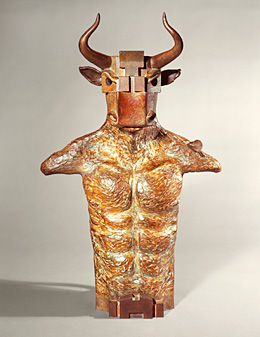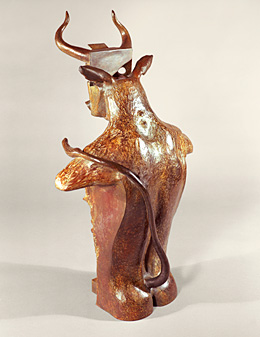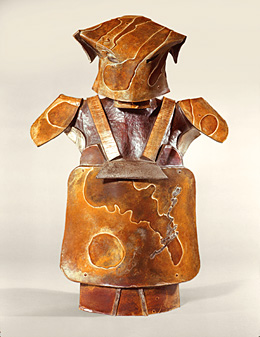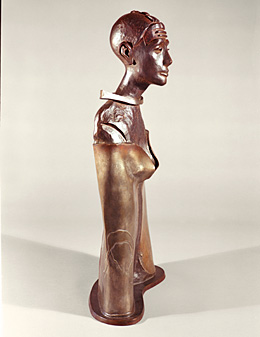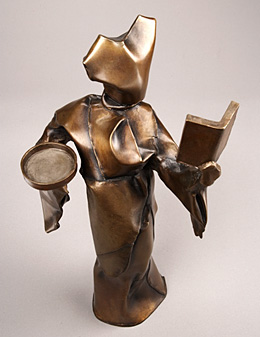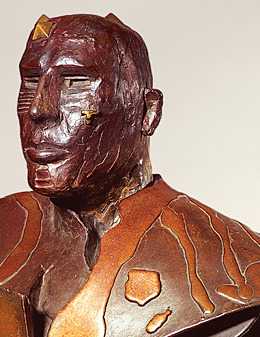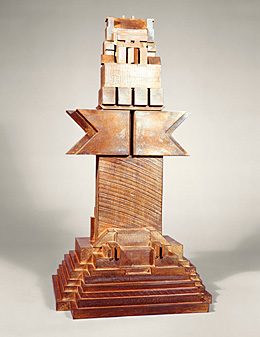|
|
|
|
|
|
|
|
|
|
|||||||||||||||
|
|
|||||||||||||||||||||||
MYTHIC SCULPTURE: Manship, DeLue, Anderson17 November 1990 to 6 January 1991 |
|||||||||||||||||||||||
MEET THE MINOTAUR, excerpts from a review by Diane Hellekson In a new exhibition at the Minnesota Museum of Art, myth soars out of the textbooks to rest in rippling bronze muscles and lithe sculpted limbs. The show takes time for Icarus and the Minotaur, yet also introduces some modern gods and imaginary warriors. It’s for aficionados of Greek mythology as well as those who prefer the heroes in “Star Wars.” “Mythic Sculpture” brings together work by three artists: Donald DeLue, Paul Manship and Roger Arvid Anderson. Viewed as a whole, the show explores the various faces of myth, and the idea put forth by Anderson (the only living artist represented) that “mythology is an ongoing process.” The three artists are connected not only by the content of their works, but by the circumstances of their lives. Anderson and Manship (1885-1966) were both born and raised in St. Paul, both influenced by the city’s architecture and art. DeLue worked as Manship’s apprentice in Paris in 1922. And a few years before DeLue’s death in 1988, Anderson met the elder artist, and later purchased two of his sculptures. ...Myth is alive for Roger Arvid Anderson, who draws inspiration not only from the great stories of other times and cultures, but from popular culture and dramatic moments in his own life and travels. Anderson, 44, has lived in San Francisco since 1972. He works in Oakland, three blocks from the freeway that collapsed in the 1989 earthquake. When 18 of his works were destroyed in the quake, he used their fragments to make one of his towering imaginary temples on view at the museum. His sinister “Storm Lord,” inspired by the doomed Teutonic knights in Sergei Eisenstein’s “Alexander Nevsky,” was created in 1982, during California’s torrential rains. Many of Anderson’s cast-bronze figures are clothed in suits that resemble medieval armor, but he says the outfits “are more related to science fiction and the technology of space suits.” Indeed, some his figures could be cousin to Darth Vader, or members of a heavy metal tag team. Others are possessed of a more feminine power, some mysteriously shrouded. “I’m looking for the visuals, the creatures to illustrate these times,” Anderson says. “The stories for my creations may not have happened yet.” One of Anderson’s most striking works is “Minotaur,” with its rippling human chest, cold geometric face and a temple entrance where his genitals should be. “As I was working on it, people I cared about were dying young,” several of them from AIDS, says Anderson. He recalls a version of the Minotaur myth in which a male and female youth were sacrificed; the artist says his sensual monster can be seen as a ruthless embodiment of AIDS. Anderson’s works are set up in the Gallery 208 space, the least grand of the Landmark Center galleries. Yet he says the narrow, snaking space is precisely what he wanted: “You come to the end of the labyrinth and you meet the Minotaur. |
|
||||||||||||||||||||||
|
|||||||||||||||||||||||
